
The 2005 Broadway smash The Color Purple now makes its Los Angeles Intimate Theater debut in a production so spectacular that it virtually redefines the term “intimate theater musical.” Brilliantly directed by Michael Matthews and starring as musically and dramatically gifted a cast as you’ll see this year on any stage large or small, this Celebration Theatre production looks to be the Intimate Theater Event of 2012.
 Based on Alice Walker’s Pulitzer Prize-winning novel and its Steven Spielberg-directed film adaptation, Broadway’s The Color Purple takes us on one African-American woman’s journey out of poverty and misery during the first half of the 20th Century. Filled with songs, laughter, and tears, The Color Purple (The Musical) benefits from Marsha Norman’s artful book, which manages to compact Walker’s 300-page epistolary novel with a minimum of dialog, the better to spotlight its over two dozen songs—music and lyrics by Brenda Russell, Allee Willis, and Stephen Bray—which run the gamut from gospel to R&B to blues to romantic ballads and back.
Based on Alice Walker’s Pulitzer Prize-winning novel and its Steven Spielberg-directed film adaptation, Broadway’s The Color Purple takes us on one African-American woman’s journey out of poverty and misery during the first half of the 20th Century. Filled with songs, laughter, and tears, The Color Purple (The Musical) benefits from Marsha Norman’s artful book, which manages to compact Walker’s 300-page epistolary novel with a minimum of dialog, the better to spotlight its over two dozen songs—music and lyrics by Brenda Russell, Allee Willis, and Stephen Bray—which run the gamut from gospel to R&B to blues to romantic ballads and back.
Walker’s story and Norman’s book introduce us to the same cast of characters we fell in love with in the 1985 movie, now given new resonance by the addition of song and dance.
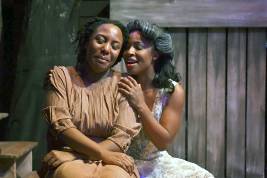 Cesili Williams takes on the role of “Po’ chil’” Celie, originated on film by an Oscar-nominated Whoopi Goldberg, and makes it indelibly her own, from her opening moments as a sexually abused teenager to the production’s thrilling finale which has her triumphantly transformed into a woman we scarcely recognize as the one we first met. Williams acts with charm and depth and sings with rich and resonant power pipes, a performance matched by her many multi-talented costars in their now iconic roles.
Cesili Williams takes on the role of “Po’ chil’” Celie, originated on film by an Oscar-nominated Whoopi Goldberg, and makes it indelibly her own, from her opening moments as a sexually abused teenager to the production’s thrilling finale which has her triumphantly transformed into a woman we scarcely recognize as the one we first met. Williams acts with charm and depth and sings with rich and resonant power pipes, a performance matched by her many multi-talented costars in their now iconic roles.
There’s Mister (Michael A. Shepperd), the hulking farmer who settles for marriage with Celie when her father refuses to let him wed Celie’s younger, prettier sister Nettie (Kelly M. Jenrette)—and then goes on to make Celie’s existence a living hell. There’s Mister’s longtime lover Shug Avery (La Toya London), the glamorous, sexy juke joint chanteuse who awakens Celie to her own beauty and self worth, the couple’s same-sex relationship just one of the reasons The Color Purple proves a perfect fit for L.A.’s esteemed LGBT theater. There’s full-figured Sofia (Constance Jewell Lopez), who earns Celie’s respect by proving via her marriage to Mister’s son Harpo (Terrance Spencer) that a woman can fight back and win. And there’s Squeak (Niketa Calame), the squeaky-voiced waitress who becomes Sofia’s rival for Harpo’s affections and inspires one of the musical’s several knock-down-drag-out catfights.
Supporting this stellar septet are ten of the most talented performers you’ll see on any stage this year, each of them executing at least one featured role in their multiple tracks, the entire bunch first introduced to us in the musical’s infectiously hummable, clappable full-cast opening number “Mysterious Ways.”
Dance captain Sixx Carter (Darlene), Lorie V. Moore (Doris), and Brittney S. Wheeler (Jarene) are the gossiping church ladies, always ready to cluck their approval, or disapproval, of the other folks in town. The “menfolks” are brought to life by Charls Sedgwick Hall (Preacher, Ol’ Mister), Corey Jones (Pa), Akula Lymon (Buster, Bobby, Older Adam), and Jonathan Thompkins (Grady), with child actresses Na’kia Bell Smith (Young Nettie) and Janet Washington (Young Celie) and soloist Jacquelin L. Scholfield completing the couldn’t-be-better cast.
There’s not a performer undeserving of raves for his or her work in The Color Purple. Shepperd is so scarily real as Mister that the changes the character undergoes become all the more powerful. London, who played Nettie in The Color Purple’s national Broadway tour, now gets the even plummer role of Shug, which she performs with a mix of sensuality, sass, and sizzle.
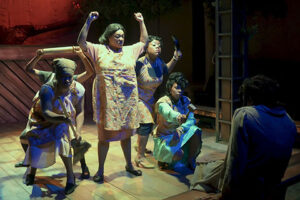 Lopez matches Oprah Winfrey’s Oscar-nominated performance as Sophia, big, brassy, and heartbreaking when broken—and unlike Oprah, this gal can sing! Jenrette is heart-breakingly real as missionary teacher Nettie, Spencer is wonderful as the haplessly henpecked Harpo, and Calame delights as petite ball-of-fire Squeak.
Lopez matches Oprah Winfrey’s Oscar-nominated performance as Sophia, big, brassy, and heartbreaking when broken—and unlike Oprah, this gal can sing! Jenrette is heart-breakingly real as missionary teacher Nettie, Spencer is wonderful as the haplessly henpecked Harpo, and Calame delights as petite ball-of-fire Squeak.
Carter, Moore, and Wheeler’s Church Ladies are hilarious, tuneful treats in their brief but frequent—and eagerly anticipated—appearances. The marvelous Hall once again demonstrates his versatility in a pair of quite different roles, and joins Jones, Lymon, Spencer, and Thompkins in production numbers which spotlight the male quintet’s triple-threat talents and all-around hotness. Smith and Washington are youthful charmers, and Scholfield solos with church-ready gospel pipes.
Musical director Gregory Nabours conducts the production’s sensational five-piece band* as cast members execute choreographer Janet Roston’s exciting dance moves in production numbers like the R&B-infused “Big Dog,” featuring the male chorus as strapping field hands, “Brown Betty,” with its “Negro spiritual” call-and-response chanting and those same field hands marking the song’s syncopated beats with farm tools, and—most breathtakingly—an African fantasy sequence that turns the tiny Celebration stage into a mini version of the Lion King, minus the animals.
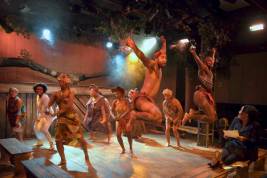 The Color Purple looks and sounds terrific thanks to a team of oh-so talented designers. Stephen Gifford makes his Celebration debut with an ingenious scenic design featuring a wooden-slatted floor, multi-purpose wooden crates and benches, and a broad expanse of sky, a design that cleverly allows the band to be both onstage and out of sight. Tim Swiss bathes Gifford’s set in a dazzling demonstration of lighting design subtlety and power. Cricket S. Myers once again proves herself a sound designer extraordinaire with her impeccable work here. Naila Aladdin Sanders’ gorgeous—and multitudinous—costumes and Michael Iran Leon’s splendid wig and makeup design take the cast of characters from the early 1900s to the mid-20th Century. Michael O’Hara takes charge of the production’s countless decades-spanning props. Fight director Sondra Mayer gets the ladies a-tusslin’ so vigorously that it’s no wonder so many of them sport kneepads.
The Color Purple looks and sounds terrific thanks to a team of oh-so talented designers. Stephen Gifford makes his Celebration debut with an ingenious scenic design featuring a wooden-slatted floor, multi-purpose wooden crates and benches, and a broad expanse of sky, a design that cleverly allows the band to be both onstage and out of sight. Tim Swiss bathes Gifford’s set in a dazzling demonstration of lighting design subtlety and power. Cricket S. Myers once again proves herself a sound designer extraordinaire with her impeccable work here. Naila Aladdin Sanders’ gorgeous—and multitudinous—costumes and Michael Iran Leon’s splendid wig and makeup design take the cast of characters from the early 1900s to the mid-20th Century. Michael O’Hara takes charge of the production’s countless decades-spanning props. Fight director Sondra Mayer gets the ladies a-tusslin’ so vigorously that it’s no wonder so many of them sport kneepads.
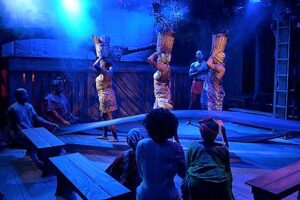 The Color Purple’s topnotch creative team also includes Ryan Bergmann and June Carryl (assistant directors), Debi White (assistant choreographer), and Zack Lapinski (associate lighting designer).
The Color Purple’s topnotch creative team also includes Ryan Bergmann and June Carryl (assistant directors), Debi White (assistant choreographer), and Zack Lapinski (associate lighting designer).
Marcedes Clanton is stage manager and Matthew Brian Denman technical director.
Working behind the scenes are Michael C. Kricfalusi (executive director-executive producer), John Michael Beck (artistic director-executive producer), Bruce Zisterer, David Elzer, and Andrew Carlberg (executive producers), Christopher Sepulveda and Cameron Faber (producers), Paul Marchegiani (associate producer), Jami Rudofsky (casting director), and O’Hara (associate managing director-production manager).
The Color Purple continues a tradition of Celebration Theatre musicals running the gamut from the one-man Songs From An Unmade Bed to the two-character BASH’d: A Gay Rap Opera to small-cast delights like [title of show] and Altar Boyz to world premieres like The Next Fairy Tale. Like The Women Of Brewster Place, another Michael Matthews-Celebration theater triumph, The Color Purple draws parallels between the African-American experience and that of the LGBT community and features a lesbian love story to boot.
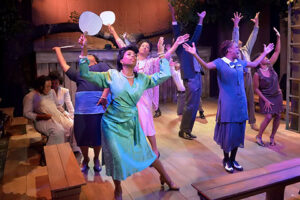 Still, as terrific as all of its predecessors have been, none has reached the heights of The Color Purple, a production which cements Michael Matthews’ reputation as one of our country’s most brilliant directors and proves beyond a shadow of a doubt that you won’t find a more gifted talent pool anywhere east of L.A. This third production of The Celebration’s 29th Season is likely to be among the hottest tickets in town throughout its limited run. Buy your tickets now because if you don’t, your face will be The Color Green with envy of those who did.
Still, as terrific as all of its predecessors have been, none has reached the heights of The Color Purple, a production which cements Michael Matthews’ reputation as one of our country’s most brilliant directors and proves beyond a shadow of a doubt that you won’t find a more gifted talent pool anywhere east of L.A. This third production of The Celebration’s 29th Season is likely to be among the hottest tickets in town throughout its limited run. Buy your tickets now because if you don’t, your face will be The Color Green with envy of those who did.
*Nabours (keyboards), Brian Morales (reeds, orchestrations), Brian Cannady (percussion, percussion consultant), David Lee (guitars) and Mike Jimenez (trumpet)
Celebration Theatre, 7051B Santa Monica Blvd., Hollywood.
www.celebrationtheatre.com
–Steven Stanley
March 9, 2012
Photos: Barry Weiss

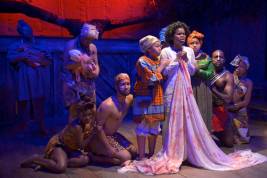

 Since 2007, Steven Stanley's StageSceneLA.com has spotlighted the best in Southern California theater via reviews, interviews, and its annual StageSceneLA Scenies.
Since 2007, Steven Stanley's StageSceneLA.com has spotlighted the best in Southern California theater via reviews, interviews, and its annual StageSceneLA Scenies.







 COPYRIGHT 2025 STEVEN STANLEY :: DESIGN BY
COPYRIGHT 2025 STEVEN STANLEY :: DESIGN BY